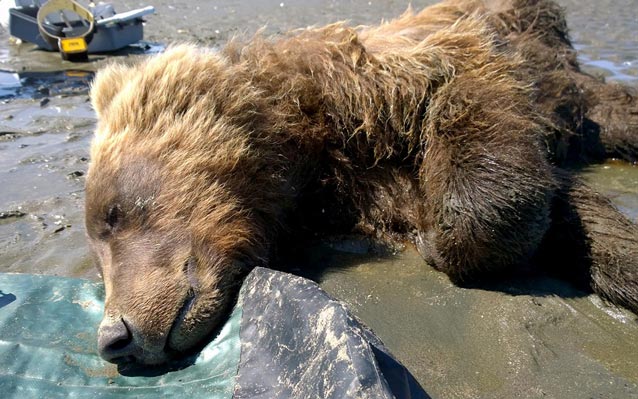Changing Tides is a three-year project that researches the importance of marine intertidal resources to brown bear health and the vulnerability of these resources to environmental changes. The study takes place in both Katmai and Lake Clark National Parks and is a collaborative effort with the U.S. Geological Survey, Washington State University, the Alaska SeaLife Center, and the National Park Service.
Bivalve Sampling

The second year of bivalve sampling along the Katmai and Lake Clark National Park coasts occurred in July 2016. Species collected included mussels, razor clams and Macoma clams. The Alaska SeaLife Center (ASLC) will assess the size, weight and shell thickness of the bivalves and use tissue samples in biomarker experiments. Tissue samples from the bivalves were also sent to the U.S. Geological Survey (USGS) to measure gene transcription. The experiments conducted by ASLC and USGS will evaluate the response of bivalves to stressors that may be present in the environment, such as elevated temperatures, pH changes (ocean acidification), pollutants and pathogens. The results of the experiments from 2015 and 2016 will allow us to compare the health of bivalves among sites, detect any changes between years and assess responses to potential environmental stressors. Additionally, in 2016, temperature loggers were deployed at several sites to determine how intertidal temperatures fluctuate over time and among sites.

Brown Bear Health

Biologists handled eight female brown bears in July of 2016 to assess their health, determine growth, collect samples for further analyses, and check GPS collars. Their weights ranged from 220 to 445 lbs and their estimated ages ranged from four years old to more than twenty. All of the bears were in good shape and gained weight between the captures. Most of the gain was muscle tissue as they replenished some reserves lost during hibernation and supporting cubs. The bears were, on average, about 10-12% body fat. We expect more significant weight gains between July and October as they begin accumulating fat for hibernation.
Remote Camera Finds

To better understand brown bear predation on marine mammals four remote cameras were set up on two different islands where sea otters and seals are known to haul out. These cameras are set to take a picture every two minutes, twenty-four hours a day, and are also triggered by motion near the camera. Reviewing this data takes awhile, but researchers have already seen evidence of brown bears preying on sea otters and harbor seals.

Bear Movement

In May, ten female coastal brown bears were fitted with GPS collars. Eight of these sows were recaptured in July. In those two months, the bears stayed within relatively small home ranges. The bears with the biggest range of movement, 026, 056, and 096 have no cubs, which could explain why they are free to roam more widely. Bear 076, in the bottom left corner of the map, has three cubs that are one year old. She stays in a smaller area in Cape Chiniak compared to Bear 026 who has been traveling along the Swikshak River.
For More Information
Questions or comments?
Visit Katmai's website or contact:
Carissa Turner, Coastal Biologist
Katmai National Park, King Salmon, AK
(907) 246-2104
Grant Hilderbrand, Wildlife Biologist
Alaska Science Center, Anchorage, AK
(907) 756-7076
Part of a series of articles titled Changing Tides Articles.
Last updated: August 5, 2016
